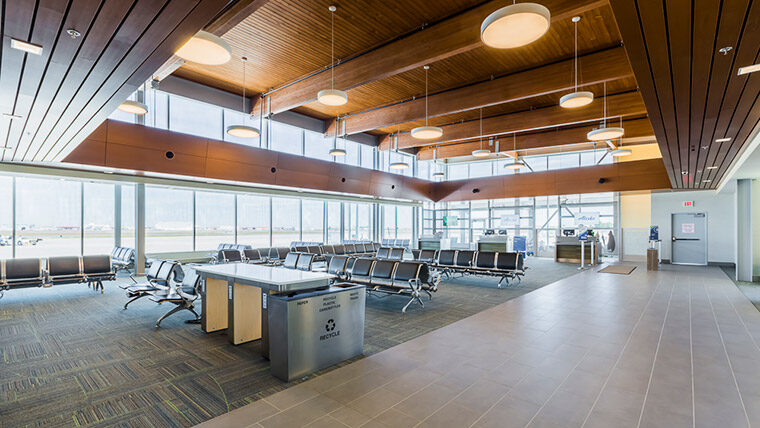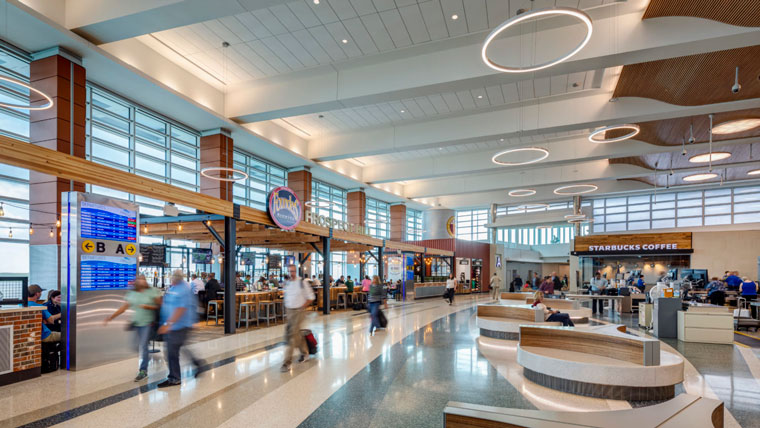In 1896, Swedish scientist Svante Arrhenius became the first person to suggest that humanity could change the climate on a global scale. It’s amazing that hundreds of years ago, we were already realizing the undeniable truth that our actions would significantly impact Earth’s health.
Today, the fact that human actions harm our planet is well known. Our built environment is just one area where we can work to mitigate these negative impacts. According to the American Institute of Architects (AIA), “Buildings represent nearly 40% of annual greenhouse gas emissions.” While preferable to new construction due to the impact on natural resources and carbon emissions, renovation also carries its own concerns, such as how to handle construction waste, furniture, fixtures, and equipment (FF&E) disposal, and the release of carbon and chemicals into the environment.
How can airport interior designers make healthier, sustainable spaces?
We must be intentional in our approach to the selection process, as well as in determining best practices to mitigate climate change. Similarly, end-of-life and thoughtful methods of disposal of severely worn or damaged goods must be considered when selecting furnishings and fixtures for the interior airport environment.
As our awareness grows, so does our knowledge and ability to work together for positive impactful change. Joining AIA’s Zero Carbon 2030 Commitment is one of many steps we all can take. Mead & Hunt has made this commitment, and our clients are helping us make tremendous strides towards making healthy choices for our publicly-shared environments, spaces, and communities. Together we are partnering in multiple new construction, expansion, and renovation projects that meet and exceed healthy emission and safety baseline levels on a consistent basis.
One example of how we intentionally design wellness-influenced and sustainable interiors is to incorporate biophilia through use of natural local flora and fauna, as well as in imagery, materiality, and materials. No one doubts that being outside in the elements promotes a healthy mind and spirit. We support our customers’ wellbeing by being mindful of this and by making careful and intentional choices. Linking the natural environment to the interior airport hold area spaces reduces stress and anxiety while promoting a sense of place.
For instance, a greenwall at the Appleton, WI airport (ATW) makes a statement while providing a link for people to experience a piece of the outdoors during all four seasons.

Working with a qualified lighting designer is another step in intentional planning. Lighting design in airports not only serves a utilitarian purpose, but also actively influences passenger functionality, temperament, and spending.
Natural lighting has been shown to help passenger health, concentration, and relaxation. Relaxed passengers are more likely to enjoy airport services such as concessions and retail spaces. Blending light temperatures and tones supplies a balanced blend of levels that, when placed purposefully, can improve moods, stimulate thinking, or provide a calm and peaceful atmosphere. Expressive lighting design enhances the overall customer experience and can serve as public art.

Locally there are several simple, cost-effective things you can do that don’t sacrifice quality or aesthetic appeal.
These include:
- Specify low to no volatile organic compounds (VOC) paints. Options on the market are plentiful, available in various sheens, and can include anti-microbial properties.
- Minimize and darken grout lines, when possible, to lower maintenance costs and the use of cleaning chemicals.
- Choose low-flow restroom fixtures to conserve water. Advances in this technology have improved greatly, and many stylish options are available, with some featuring integrated soap dispensers and hand dryers.
- Avoid Red List chemicals, which include asbestos, bisphenol A (BPA), polyvinyl chloride (PVC), chlorofluorocarbons, and formaldehyde.
- Choose FF&E items that feature Declare and GreenGuard labels, are Energy Star rated, and have undergone LEED and WELL evaluation.
- Use antimicrobial visible LED light, which is confirmed to deactivate viruses including SARS-CoV-2, MRSA, C. diff and several STAPH infectious pathogens.
Good design not only needs to be aesthetically pleasing, but should also support the environmental, health, wellbeing, and emotional needs of all building occupants. By making this intentional commitment to providing a truly healthy environment, we all benefit.



